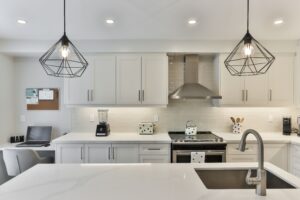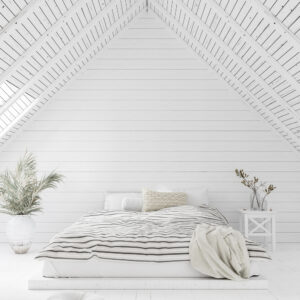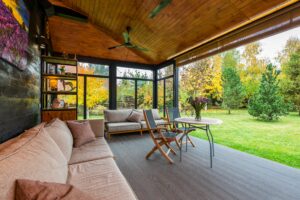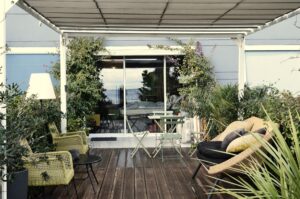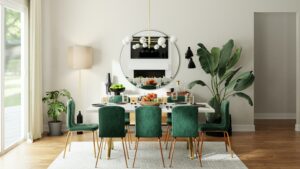Sustainable interior design case studies, highlighting green practices, offer a compelling glimpse into the innovative ways in which design and sustainability intersect to create harmonious living spaces. From energy-efficient solutions to eco-friendly material choices, these case studies showcase the transformative power of sustainable design in enhancing both aesthetics and environmental impact. Join us on a journey through these inspiring examples of sustainable interior design practices that prioritize planet-friendly choices and elevate the standard of eco-conscious living.
Energy-Efficient Lighting Solutions
In the realm of sustainable interior design, lighting plays a crucial role in both aesthetics and energy efficiency. Let's delve into some case studies that highlight green practices in energy-efficient lighting solutions.
Case Study 1: Implementing LED Lighting
-
LED lighting has revolutionized the way we illuminate our spaces by offering energy-efficient alternatives to traditional incandescent bulbs.
-
By switching to LED lights, interior designers can significantly reduce energy consumption and lower electricity bills.
-
Incorporating smart lighting systems with motion sensors and programmable settings further enhances the eco-friendly aspect of LED technology.
Benefits of Natural Light and Smart Lighting
-
Harnessing natural light through strategically placed windows, skylights, and light tubes not only reduces the need for artificial lighting but also creates a healthier indoor environment.
-
Smart lighting systems that adjust brightness based on natural light levels and occupancy patterns contribute to optimizing energy use while prioritizing occupant comfort.
Impact of Lighting Design on Sustainability
-
Sustainable interior design goes beyond aesthetics to consider the environmental impact of lighting choices.
-
By selecting energy-efficient fixtures and implementing lighting controls, designers can minimize the carbon footprint of a space and promote sustainable practices.
-
Sustainable lighting design not only reduces energy consumption but also contributes to the overall well-being of occupants by creating a visually appealing and eco-conscious environment.
For further insights on sustainable lighting solutions, you can explore Philips Lighting's sustainable practices.
Eco-Friendly Material Selection
When it comes to sustainable interior design, choosing the right materials can make a significant difference in reducing environmental impact. Let's explore some case studies that demonstrate the importance of eco-friendly material selection and highlight green practices.
Case Study 2: Recycled and Upcycled Materials
-
Utilizing recycled materials like reclaimed wood, salvaged metal, and repurposed fabrics can give a unique character to interior spaces while promoting sustainability.
-
Upcycling materials into new design elements not only reduces waste but also adds a touch of creativity and eco-consciousness to the overall design aesthetic.
-
Incorporating sustainable materials in furniture and decor showcases a commitment to environmental stewardship and sets a positive example for sustainable living practices.
Advantages of Sustainable Material Choices
-
Sustainable materials offer durability, functionality, and visual appeal without compromising on eco-friendliness.
-
Choosing materials with low environmental impact and high recyclability contributes to a circular economy model and reduces the depletion of natural resources.
-
By prioritizing eco-friendly material selection, interior designers can inspire clients and industry peers to embrace green practices and support sustainable initiatives.
How Material Selection Contributes to Environmental Conservation
-
The construction and design industry has a significant environmental footprint, making conscious material choices crucial for reducing carbon emissions and waste generation.
-
Opting for sustainable materials minimizes the negative impact on ecosystems, wildlife, and communities involved in the production and extraction processes.
-
Investing in environmentally-friendly materials not only benefits the planet but also creates healthier indoor environments for occupants by reducing exposure to harmful chemicals and pollutants.
For further inspiration on eco-friendly material options, you can explore Interface's sustainable flooring solutions.
Indoor Air Quality Improvement
Ensuring good indoor air quality is essential for creating healthy and sustainable interior spaces. Let's explore some case studies that focus on improving indoor air quality through green practices in sustainable interior design.
Case Study 3: Incorporating Plants for Air Purification
-
Indoor plants not only add a touch of nature to interior spaces but also act as natural air purifiers by filtering out toxins and improving air quality.
-
By strategically placing air-purifying plants such as spider plants, peace lilies, and snake plants, designers can enhance the aesthetic appeal and well-being of occupants.
-
Green walls and vertical gardens not only contribute to indoor air quality improvement but also promote biophilic design principles that connect people with nature.
Importance of Ventilation and Non-Toxic Finishes
-
Proper ventilation systems ensure adequate air circulation, reducing the buildup of indoor pollutants and enhancing overall indoor air quality.
-
Choosing non-toxic paints, finishes, and materials for interior surfaces minimizes off-gassing and creates a healthier indoor environment for occupants.
-
Sustainable interior design practices that prioritize ventilation and non-toxic finishes align with green building standards and certifications, emphasizing the importance of indoor air quality in sustainable design.
Enhancing Occupant Health and Well-Being
-
Sustainable interior design goes beyond aesthetics to prioritize the health and well-being of occupants through indoor air quality improvement initiatives.
-
By incorporating green practices that focus on air quality enhancement, designers create spaces that promote mental clarity, productivity, and overall wellness.
-
Educating clients and stakeholders on the benefits of indoor air quality improvement in sustainable design fosters a commitment to creating healthier living and working environments.
For additional resources on indoor air quality improvement, you can explore Carrier's sustainable HVAC solutions.
Sustainable Furniture Design
Sustainable furniture design plays a significant role in promoting eco-conscious interior spaces. Let's explore case studies that exemplify sustainable practices in furniture design and highlight green initiatives.
Case Study 4: Eco-Friendly Furniture from Renewable Resources
-
Designing furniture using renewable resources such as bamboo, cork, and reclaimed wood showcases a commitment to sustainable practices and environmental stewardship.
-
Sustainable furniture pieces made from renewable materials are not only durable and aesthetically pleasing but also contribute to reducing carbon footprint and promoting circular economy principles.
-
By choosing eco-friendly furniture options, interior designers can inspire clients to embrace sustainability and support ethical manufacturing practices in the furniture industry.
Durable and Biodegradable Materials
-
Sustainability in furniture design goes beyond materials that are just environmentally friendly; it also involves choosing durable and biodegradable options that have a minimal impact on the planet.
-
Biodegradable materials like natural fibers, organic textiles, and responsibly sourced wood align with green practices and contribute to a healthier environment.
-
Investing in furniture made from durable and biodegradable materials ensures longevity, reduces waste generation, and supports the transition towards a more sustainable and eco-friendly future.
Promoting Ethical Manufacturing Practices
-
Sustainable furniture design encompasses not only the materials used but also the manufacturing processes involved in creating each piece.
-
Companies that prioritize ethical manufacturing practices, fair labor conditions, and sustainable production methods set a benchmark for responsible and eco-conscious furniture design.
-
By supporting brands that uphold ethical standards in manufacturing, consumers contribute to the promotion of sustainable practices and drive positive change in the furniture industry.
For more insights on sustainable furniture solutions, you can explore IKEA's commitment to sustainable design.
Water Conservation Strategies
Water conservation is a vital component of sustainable interior design, emphasizing the responsible use of water resources. Let's explore case studies that showcase green practices in water conservation and highlight the importance of sustainable water management.
Case Study 5: Implementing Water-Saving Fixtures
-
Incorporating water-saving fixtures such as low-flow faucets, showerheads, and toilets significantly reduces water consumption and supports sustainable water management.
-
Efficient fixtures help minimize water wastage without compromising functionality, providing a practical solution for conserving water in interior spaces.
-
By integrating water-saving fixtures, designers demonstrate a commitment to environmental conservation and encourage water-conscious behaviors among occupants.
Impact of Sustainable Plumbing Design
-
Sustainable plumbing design focuses on optimizing water efficiency, reducing leaks, and promoting the responsible use of water throughout a building or living space.
-
Implementing recycled water systems for non-potable uses like irrigation and cooling further reduces the demand for freshwater resources and minimizes environmental impact.
-
Sustainable water management practices not only conserve water but also contribute to lower utility bills, promoting cost savings for property owners and residents.
Importance of Water-Efficient Practices
-
Water-efficient practices play a crucial role in sustainable interior design by addressing the global water crisis and reducing water stress on local ecosystems.
-
By adopting water-conserving strategies, designers and homeowners can contribute to water sustainability goals, conserve resources, and mitigate the effects of water scarcity.
-
Promoting water-efficient practices in interior spaces encourages a culture of water stewardship, fostering a sense of responsibility and environmental awareness among occupants.
For further inspiration on water conservation solutions, you can explore Kohler's water-saving plumbing products.
Conclusion: Embracing Sustainable Interior Design Innovations
In conclusion, sustainable interior design case studies that highlight green practices offer valuable insights into creating environmentally friendly and aesthetically pleasing spaces. By integrating eco-friendly solutions and promoting sustainable living principles, designers can make a positive impact on the planet and enhance the well-being of occupants.
Key Takeaways:
-
Sustainable interior design is essential for reducing environmental impact and promoting a healthier living environment.
-
Green practices such as energy-efficient lighting, eco-friendly material selection, indoor air quality improvement, sustainable furniture design, and water conservation strategies play a crucial role in sustainable design.
-
By incorporating sustainable strategies and embracing innovative solutions, designers can inspire clients, industry peers, and communities to adopt eco-conscious behaviors and support sustainable initiatives.
Looking Ahead:
As the demand for sustainable interior design continues to grow, it is essential to stay updated on the latest trends, technologies, and developments in green practices. By collaborating with industry leaders, advocating for sustainable design principles, and embracing eco-friendly innovations, we can collectively work towards a more sustainable future for interior spaces.
For additional resources and inspiration on sustainable design practices, you can explore Interface's sustainability initiatives. Let's continue to nurture our planet through sustainable interior design innovations and make a positive difference for current and future generations.
FAQ
How can sustainable interior design benefit both the environment and occupants?
Sustainable interior design practices not only reduce the environmental impact of spaces but also promote healthier indoor environments for occupants. By incorporating eco-friendly materials, energy-efficient systems, and sustainable practices, designers can contribute to environmental conservation and enhance the well-being of those who inhabit the space.
What are some key features to look for in eco-friendly furniture?
When choosing eco-friendly furniture, look for pieces made from renewable resources, such as bamboo or reclaimed wood. Opt for durable and biodegradable materials that have a lower environmental impact. Consider furniture brands that prioritize ethical manufacturing practices and sustainable design principles.
How can indoor air quality be improved in sustainable interior design?
Improving indoor air quality in sustainable interior design can be achieved by incorporating air-purifying plants, ensuring proper ventilation, and using non-toxic finishes and materials. These practices help reduce indoor pollutants, promote better air circulation, and create a healthier living environment.
Why is water conservation important in interior design?
Water conservation is crucial in interior design to minimize water wastage, support sustainable water management, and reduce the overall environmental footprint of a space. Implementing water-saving fixtures, efficient plumbing systems, and recycled water solutions can contribute to water sustainability goals.
What role does lighting play in sustainable interior design?
Lighting is essential in sustainable interior design as it influences energy consumption, occupant comfort, and the overall ambiance of a space. By using energy-efficient lighting solutions, harnessing natural light, and implementing smart lighting controls, designers can minimize energy use and create environmentally conscious interiors.


